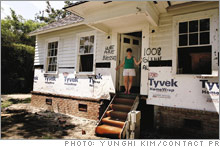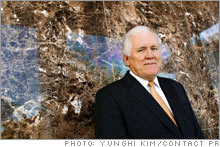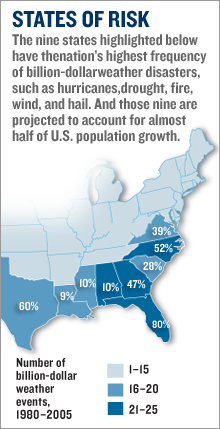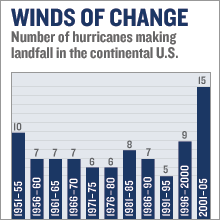Risky BusinessWith $58 billion in claims to pay for last year alone, U.S. insurers are jacking rates, canceling policies and learning to cope with climate change.(Fortune Magazine) -- Mary Alice and Jos� Mart�n's bungalow survived Katrina - but got hit in June. That's when Allstate informed the couple that their home, a mile from the glistening Gulf of Mexico, would no longer be covered for windstorm or hail. "Here it is the middle of hurricane season," Mrs. Mart�n fumes. "Who in the world is going to sell me a windstorm policy right now?"
The Mart�ns are hardly alone. All along the Gulf Coast and Eastern seaboard, most major home and commercial insurers, including Allstate (Charts), Nationwide (Charts), State Farm, and St. Paul Travelers (Charts), are variously increasing premiums, ratcheting up deductibles, narrowing terms of coverage, and turning away new customers. In 18 states, from southern Texas to the northern tip of Maine, insurance companies are scrambling to reduce the risk of major hurricane-related payouts. The upshot: For the 43% of the U.S. population who live and do business in these states, rates are likely to rise between 20% and 100% over the next year, according to the Insurance Information Institute. (In the rest of the country, premiums are expected to rise about 4%.) The insurance business is in the midst of a sea change. Unpredictable weather, American migratory patterns, and soaring real estate values are increasing risks for insurers and putting pressure on their financial prospects. In response, companies are changing the rules of engagement with their customers. It's not the best PR move for an industry still mired in post-Katrina lawsuits. Nonetheless, the effects are already being felt in places like Gulfport, Miss., and Cape Cod, where homeowners' insurance coverage is becoming more expensive, harder to get - or both. Critics blame the industry, saying it is using the trauma of Katrina as a ruse to raise rates. Insurers, though, blame the weather. A changing climate shakes the industry Says Allstate CEO Edward Liddy: "We are in a period of increased land and sea surface temperatures. When you couple that with more people living along coasts and dramatically increased home values in those areas, that's when you step back and you say, 'Wait a minute. This is not yesterday's game.' " Publicly, insurers have not accepted the theory of global warming, which says that the accumulation of greenhouse gases - in part because of activities like burning fossil fuels - is changing weather patterns. What the industry does believe is that, for whatever reason, weather isn't what it used to be. Insurers are the world's best fortunetellers. Your insurance provider can reveal more about your future than you care to know: the likelihood of your teenager's getting into a fender-bender; the number of years a daily bran muffin can add to your life; or whether your home's brick foundation will last another 50 years. The actuarial formulas that provide those answers are the cornerstone of the business. Until recently, insurers were convinced that their calculations for predicting hurricane damage - known as "catastrophe models" - were accurate. But the 2004 and 2005 Atlantic hurricane seasons were off the charts: Seven of the ten most destructive storms in U.S. history occurred in those years; 2005 saw a record $58 billion in insured losses. The 2005 season "shook insurers' confidence in their models," says Robert Klein, director of the Center for Risk Management and Insurance at Georgia Tech University. Debate flares over reliability of risk models Enter Robert Muir-Wood, a dapper British catastrophe specialist who has been modeling weather since the mid-1980s. A decade ago Muir-Wood joined the insurance industry's primary source of catastrophe-programming tools and data, Risk Management Solutions (RMS), based in Newark, Calif. He is now its chief of research. What "cat modelers" like Muir-Wood do is fairly straightforward. If an insurer wants to estimate, say, potential losses from a hurricane striking Miami, modelers plug a series of data points into a standard formula. First they assess the likelihood of such an event by reviewing historical weather data, plotting area locations where past hurricanes struck land, then tracing the paths those storms took. Next they factor in the insurer's inventory of policies held, using street addresses, zip codes, and other geographic coordinates, taking into account each building's height, age, and structure. Putting it all together, number-crunchers estimate possible losses - the cost of rebuilding structures, relocating displaced families, and compensating for business interruptions - minus any special terms in the policyholders' contracts, such as deductibles and coverage limits. It's a tidy methodology - but does it still work? That was the question many insurers were asking. Muir-Wood says cat modelers have always accepted the 100-year average of history for forecasting future hurricanes. But since the mid-1990s, hurricane activity in the Atlantic has increased in both frequency and severity, according to data compiled by the National Oceanic and Atmospheric Administration (NOAA). From 1985 to 1994, an average of nine hurricanes per year formed in the Atlantic; an average of one each year was severe (categories 3 to 5). From 1995 onward, an annual average of 16 storms formed. On average four were severe. The question is whether this change is an anomaly or the beginning of a new pattern. Rather than rely on his hunch that weather history was becoming bunk, Muir-Wood gathered four of the world's best minds on the subject of hurricanes. He put them in a hotel conference room in Bermuda last October, and asked them to slog it out until they reached a consensus forecast for hurricane activity. Experts reach a consensus Muir-Wood's main objective was to decide whether the 100-year history of Atlantic hurricanes could still serve as a guide for devising insurance models for future disasters. And what happened in that hotel room is now making itself felt in tens of millions of living rooms and offices. Consensus did not come easily. The experts held varying opinions on many aspects of hurricane behavior. There was MIT professor Kerry Emanuel, for instance, an expert on thermodynamics and climatology. Emanuel, a recent convert to the theory of global warming, had just concluded research that found a link between rising sea-surface temperatures and the increasing destructiveness of hurricanes. Another participant was Jim Elsner, a professor of geography at Florida State University and an authority on the mechanisms controlling hurricane frequency and their tracks. Elsner's work centers on what he believes are rather predictable multiyear cycles of increasing and decreasing hurricane activity. These cycles have remained unchanged for eons, he believes, and therefore may not be attributed to global warming. Tom Knutson of NOAA focuses on the possible long-term effects - well into the century - of greenhouse gas accumulation on hurricanes and typhoons. Mark Saunders, a professor of geophysics at University College London and an authority on hurricane forecasting, is a staunch believer that human activity is causing global warming in the form of rising sea-surface temperatures - the chief cause of increased hurricane activity. With the window shades pulled to prevent the sun's glare from obscuring their projection screen, Elsner, Emanuel, Knutson, and Saunders haggled over the weather charts. Muir-Wood moderated the discussion. Emanuel recalls he didn't like being asked to make definitive forecasts. "What's that Yogi Berra quote? 'Prediction is very hard, especially when it's about the future,' " he jokes. "The problem I have as a scientist is, I like to attach very large caveats to things." Emanuel took issue, for example, as did Knutson, with Elsner's and Saunders's assumption that there was a strong connection between increased hurricane frequency since 1992 and the rate at which hurricanes struck land. But on the big question - whether hurricane patterns in the near future will resemble those of the past century or the accelerated pattern of the past decade - the four unanimously agreed. In the next ten to 15 years, they said, severe hurricanes would strike land 30% more often than in the past century. On that basis, Muir-Wood went back to the drawing board. "It is now unwise and unsafe to use the historical baseline to view future financial risk," RMS warned insurers last winter. Insurers feel the squeeze The influence of this new math is cascading onto other financial sectors, ultimately putting further pressure on insurers. Even as insurers begin readjusting the risk they carry in 18 coastal states, rating agencies are prodding them to maintain higher surpluses in anticipation of larger future payouts. At the same time, reinsurance - the insurance that insurers purchase to hedge risk - is becoming scarcer and more expensive. Reinsurers like XL Capital and Swiss Re are based in Bermuda and Europe, making them exempt from U.S. pricing regulations. They have begun charging higher rates, both to make up for last year's payouts and to build reserves against future disasters. Squeezing insurers from the other direction are the state insurance commissioners who regulate rates and try to hold them down. "It's been a persistent and severe problem that state commissioners suppress premiums well below rates necessary to cover risk in some areas," says Robert Hartwig, executive vice president and chief economist at the Insurance Information Institute, an industry trade group. When they cannot charge what they believe is necessary, insurers either reduce coverage or simply pull out. Then there is the matter of demographics. Over the next 30 years, more than half of projected U.S. population growth is expected to come in the states being hit the hardest by extreme weather - events like drought, fire, tornadoes, and hurricanes. And thanks to what State Farm CEO Ed Rust Jr. calls "America's love affair with warm water and warm weather," the most vulnerable parts of those states - coastal areas - are growing fastest of all. "It's like in California, you go up into the most beautiful areas back in the canyons," says Rust. "But about every ten years you get a wildfire going through, and everything's gone. And you ask people, 'Well, why do you live there?' And they say, 'Well, it's beautiful for ten years, and then you rebuild.' Which raises the question, Who should pay for all that?" The answer to that question is playing itself out in similar ways at various companies and in several regions. Concerned that the Northeast is overdue for a major hurricane - the last one was in 1938 - many property and casualty insurers are scaling back. In Massachusetts, Hingham Mutual Insurance, citing higher storm damage projections and rising reinsurance rates, said recently it will not renew some 6,500 homeowner policies this year on Cape Cod, Martha's Vineyard, and two coastal Massachusetts counties. Allstate, the nation's No. 2 personal-property insurer, said this year it would no longer offer new policies on Long Island, in New York City, and Westchester County as part of a broad effort to reduce the company's "risk profile" along the Gulf and East Coasts. In South Carolina, Lexington Insurance (a division of AIG) is restricting new business to homes valued above $500,000. Allstate has stopped writing new policies in parts of the state. After being hit with seven hurricanes in the last two seasons, Florida is close to a full-blown insurance crisis. In 2005, Allstate canceled 95,000 homeowner's policies in Florida. The company plans not to renew 120,000 policies by November and is writing no new policies in the state. Allstate is severely limiting its risks in Florida, in part because the state is one in which "we do not get adequate rates in that regulated system," says Allstate CEO Edward Liddy. "If you talk to someone from Florida, they say, 'Boy, in the last five years, my home has gone up 80% in value,' " says Liddy. "But if you ask them, 'Well, are you paying 80% more for your insurance?' they would say, 'Oh, no! I only want to pay 8% more.' There's a disconnect." As insurance becomes scarcer, a growing number of Florida homeowners are seeking policies from the state-funded insurer of last resort, Citizens Property Insurance Corp. Created by the Florida legislature after private insurers retreated from the state in the wake of Hurricane Andrew in 1992, Citizens is now Florida's largest home insurer. Last June, Florida's state legislature was forced to bail out the fund with $715 million from the state's surplus. Meanwhile, the number of Citizens policyholders continues to grow, jumping from 777,000 in 2004 to some 1.2 million today. Many of those homeowners have seen their premiums double in the past year. Ripple effect Gulfport, Miss., home to the Mart�ns, is as good a place as any to get a sense of how rising insurance costs can ripple through a community. Mayor Brent Warr, a 43-year-old Republican with the looks and shine of a fresh-out-of-the-box Ken doll, was seven weeks into his first term when Katrina hit. Almost a year later, he turns his dusty Ford pickup onto Highway 90. The Gulf of Mexico is on one side, empty lots on the other. Warr points excitedly at the sites of future construction projects. "That's all been zoned for condos," he says, waving his hand toward one lot. "A big hotel's going over here," he says, speeding past another. Despite Katrina, Gulfport's economic pulse is certainly beating. In the past year the city has added nearly 1,500 jobs, mostly in manufacturing and shipbuilding. The new economic activity, combined with an exodus of families affected by Katrina, has created a labor shortage. Still, while Gulfport is brimming with optimism, it is also feeling the tremors of the insurance upheaval. Some 3,500 homes were destroyed. Many of Gulfport's 71,000 residents (the population pre-Katrina) are waiting for their insurance settlements - or worse, they're involved in one of the many lawsuits against insurers over Katrina flood claims. "These insurance issues - the slow claims payments from Katrina and the skyrocketing premiums afterwards - are the only thing holding us back," says Warr. That may be taking optimism too far. As insurers retreat from the Gulf Coast, a growing number of homeowners are signing up for the state-run Mississippi Windstorm Underwriting Association. Before Katrina, the "windpool," as Mississippians call the state insurer of last resort, covered homes and businesses worth $1.8 billion. By the end of this year, the total coverage is expected to rise to $4 billion. For the owner of a $250,000 home, state windpool premiums rose 97% this year, to roughly $3,500. Mississippi insurance commissioner George Dale fears the windpool could end up like Florida's overburdened disaster-insurance program. He's been on a campaign to keep private insurers on the coast. "We've had several unofficial conferences with many of the companies, where we've begged, pleaded, implored them to continue writing new business on the coast," says Dale. To little avail: "Only Farm Bureau and Allstate have indicated they'll continue to write - but without wind coverage." Construction costs are also on the rise as a result of higher insurance premiums. From big, multimillion-dollar casino projects to small jobs like raising home foundations to meet new FEMA building codes, Gulfport is rebuilding - at a cost. Wind coverage "used to be 0.5% of total building costs," says Henry Martinez, CEO of GM&R Construction, based in Waveland, Miss. "Now it's 3% - if you can get it." Builders naturally pass on the increased cost of premiums and bigger deductibles. Those rising costs concern John Walton, regional president of Whitney National Bank. "It's already affecting the building of affordable housing," says Walton. "We need to have places for people making $40,000 a year. That's who worked in the casinos and the hotels here. Those people are gone, and we need them back." With the city's own annual premium up 50%, to $1.5 million (out of an annual budget of roughly $50 million), Warr trimmed costs by leaving playgrounds, park fences, gazebos, and the like uninsured for catastrophe loss. Critics of the insurance industry say the new models are just an excuse to raise premiums. In June, J. Robert Hunter, director of insurance at the Consumer Federation of America (CFA), testified before Congress that "RMS has become the vehicle for collusive pricing" among insurers. "It's clear that the insurance industry sought this move to higher rates," he told the Senate Judiciary Committee last June. It's a fair criticism that competition among risk modelers is not as robust as it could be: RMS and its two competitors, AIR Worldwide and Equecat, help to set prices for the entire industry. Insurers insist that they are facing real pressures. That is true enough, but don't get out the violins just yet. Insurance is the world's biggest industry ($3.4 trillion in annual revenues, compared with a mere $1.6 trillion for Big Oil). And even with all its disasters, 2005 was a very profitable year for U.S. property and casualty insurers. Collectively, they saw profits rise 11%. Still, convinced weather-related disasters will cause more and more damage, companies are looking beyond higher premiums for answers. Liddy helped draft legislation that would diminish the states' powers to regulate rates, while setting up a national disaster reinsurance fund seeded with capital from insurers. Untethering insurers from price regulation and bringing in the government as a reinsurer sounds like a massive bailout to critics. CFA's Hunter also wonders, "Why should we be adding another thing for the federal government to screw up?" But Liddy - who likes to point out that it was the insurance industry that created the nation's first fire departments - insists that involving the federal government as a backstop makes sense. The politics are only beginning. But there is little doubt that a large chunk of the country will see its spending power, already eroded by high energy prices, further drained by escalating insurance costs. Moreover, the states being hit hardest may find sharply higher insurance costs a deterrent to new investment. In a sense, higher insurance rates are a tax - people have to pay up, and the rate affects everyone, directly or indirectly. One immediate outcome: "This has got to have a depressing effect on housing markets," says Robert Litan, an economist with the Brookings Institution. "The extra cost of insurance will be a haircut on the value of your house." The Mart�ns, by the way, finally did get insurance, this time from State Farm. But now the premium is $3,000, almost three times what they paid Allstate in 2005. From the September 4, 2006 issue
|
|





